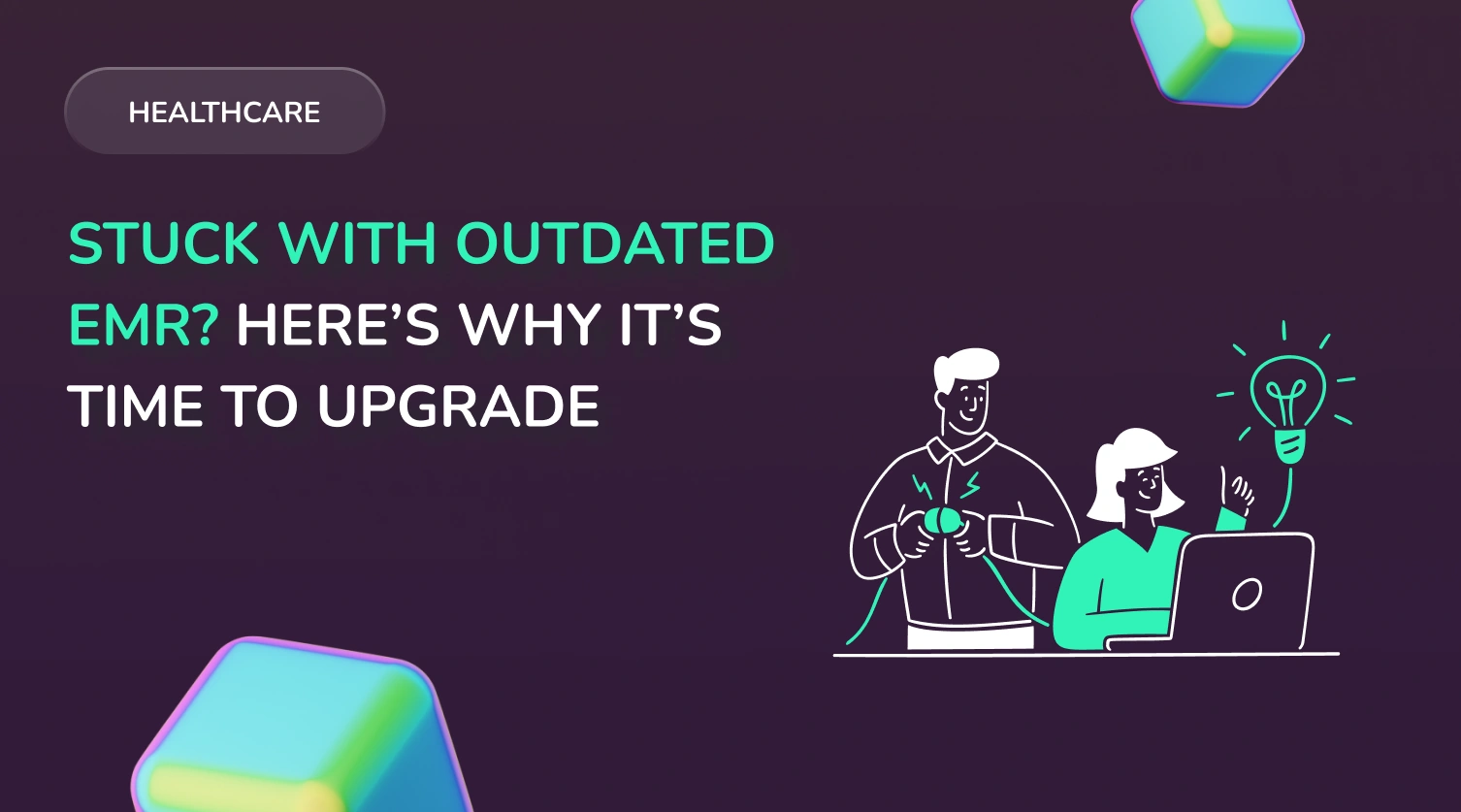
Legacy EMR systems are outdated electronic medical records that are still in use in many healthcare facilities. While they were once cutting-edge, now these systems hinder progress in modern digital healthcare due to poor integration, difficult maintenance, and security vulnerabilities.
But how do you spot whether you are using the legacy system or if it is still completely fine to use? How do you create a new system, and do you need it? Let’s examine all of that today!
What is a Legacy EMR?
A Legacy EMR (Electronic Medical Record) is an outdated electronic medical system implemented many years ago, no longer meeting current technological, functional, or security standards.
One of the main challenges with old EMR systems is that many clinic networks, or even entire healthcare systems, are reluctant to fully migrate all data to a modern platform.
As a result, doctors may be using a new system, but part of the patient data remains stored in the old one. This situation creates the need to integrate the legacy system with the new one to ensure continuity and accessibility. Let’s quickly grab the 8 most crucial signs of the legacy EMR.
| Sign | Description |
| Poor interoperability | Can’t integrate with other systems or standards such as HL7, FHIR, or third-party lab/pharmacy/insurance services. |
| Limited mobility and hardware dependency | Only works on stationary computers with outdated operating systems (e.g., Windows XP). |
| No web or mobile access | Lacks browser-based interfaces or support for smartphones and tablets. |
| Complex, outdated interface | Unintuitive navigation, excessive clicks for basic actions, and no adherence to modern UX/UI principles. |
| No cloud architecture | Requires local servers, making remote access difficult or impossible. |
| Security vulnerabilities | Lacks modern encryption, access logs, two-factor authentication (2FA), and other cybersecurity measures. |
| No vendor support or updates | The vendor has stopped updating the system or has gone out of business. |
| Limited analytics and clinical decision support | No structured reports or tools to help physicians make evidence-based decisions. |
The most well-known legacy EMRs in the U.S. are Meditech Magic, Vista (VA), GE Centricity EMR, and other in-house hospital software from the late 90s and early 00s, often built on FoxPro, MS Access, or Delphi with no upgrade path.
Why Legacy EMRs Are a Problem for Healthcare
The first electronic medical record (EMR) systems were introduced as far back as the late 1980s as tools for MS-DOS and Windows 3.0. Many of those EHRs are still in use today. Just imagine how much data has accumulated in such systems over 40+ years.

Everything has its preferred lifespan. And legacy EMR already surpassed it a few decades ago
However, despite their historical significance, legacy systems in healthcare are no longer viable in their original form. They are built on outdated architectures and do not comply with modern standards and laws.
Over time, Legacy EMRs become increasingly inefficient, while the cost of maintaining them continues to rise. They not only hinder a healthcare organisation’s digital shift but also directly impact the quality and safety of care delivery. To help you understand why you may need a new system, we’ve examined 5 major drawbacks of the old systems.
1. Data Exchange Limitations
With interoperability, systems can communicate using standardised formats, such as HL7 FHIR or API integrations. Unfortunately, old systems don’t support them.
As a result, clinicians may lack access to a comprehensive view of a patient’s health. The lack of proper EMR management becomes especially dangerous in emergencies or complex, multidisciplinary care.
The lack of interoperability hinders integration with labs, insurers, telehealth services, and national health platforms. Any data sharing or customization attempt often requires manual processes or technically complex workarounds, increasing delays and error rates.
In 2014, at the Bristol Royal Hospital for Children in the UK, a three-year-old heart patient died due to a delay in treatment. The hospital implemented the Cerner Millennium system, but some appointments refused to migrate, which led to the patient not being seen or treated in time.
Non-Compliance with Modern Security Standards
Many legacy EMRs were developed when companies did not care about cybersecurity that much, so they fall short of today’s data protection requirements. Legacy EHR and EMR typically lack encryption for data at rest or in transit, have no two-factor authentication (2FA), lack access audit logs, and offer poor user access controls.
It makes them vulnerable to data breaches, cyberattacks, and unauthorized legacy data access. A single breach could lead to legal consequences, reputational damage, and hefty financial penalties. With the rise of cyberattacks, you need to ensure top-notch data security.
In 2018, Singapore’s SingHealth faced a massive data breach, where hackers stole personal data of 1.5 million patients. After that, they’ve started to change legacy systems to new ones.
Limited Vendor Support and System Updates
Legacy systems often no longer receive regular updates from the original vendor. Sometimes, the vendor may have shifted entirely to newer products, leaving legacy solutions obsolete and unsupported.
It makes the EMR maintenance unbearable for you. Facilities are forced to run outdated software on old operating systems, compounding the risk of security vulnerabilities and maintenance costs.
Worse still, the system is not updated and may face regulatory fines. In 2016, the Nanaimo Regional General Hospital in British Columbia implemented a new electronic health record system. The $230 million project faced widespread criticism due to software errors. An investigation revealed that the project was not correctly implemented, leading to all these glitches.
High Cost of Maintenance and Modernization
While keeping the old system might seem cost-effective on the surface, the cost of maintaining legacy systems can be very high in the long run. These systems often depend on outdated or highly specialized hardware that is difficult (or impossible) to replace. Maintaining them might require niche expertise that’s becoming harder to find.

Sometimes supporting legacy ERM makes businesses feel that they are burning money. So, it’s easier to start
Due to poor automation and clunky interfaces, they increase the administrative burden on staff, raising indirect labor costs. Even basic changes, such as adding a module, can take months to develop.
In 2015, Anthem Inc., a major health insurer, suffered a data breach affecting almost 80 million individuals. The breach exploited vulnerabilities in their legacy systems, leading to a settlement of $115 million.
Lack of Flexibility for Innovation (AI, Telemedicine, Mobile Access)
Modern healthcare rapidly embraces digital innovations, from AI-powered decision support to telehealth and mobile-first workflows. Legacy EMRs simply can’t support such functionality.
Their architecture is rigid, the code is often closed, and APIs may not exist. The data migration from legacy systems is quite challenging, so it becomes easier just to download everything and shut the original system down. Adding an AI imaging module or a patient chatbot could require massive system rewrites to the point that this system catches too many bugs and shuts down.
In 2016, Danish health authorities implemented the Epic System across 18 hospitals. The rollout faced significant challenges, including translation issues and a complicated user interface. Physicians reported that the system was too complex, leading to patient safety concerns and calls for removal.
How Legacy EMR Systems Affect Patients, Clinicians, and Managers
Old systems significantly restrict your efficiency. Due to EMR issues, patients may face treatment delays or mismatches. Take the Finnish Apotti system: its confusing interface directly led to medication errors, proving that even high-tech EMRs can cause harm if usability is overlooked.
Clinicians are also becoming burdened with unintuitive interfaces and disconnected workflows, leading to frustration, burnout, and reduced care quality. In the U.S., doctors have reported seeing fewer patients per day and losing trust in EMR tools due to inefficiencies.
Meanwhile, administrators spend excessive time and money maintaining outdated platforms, diverting resources from innovation and strategic growth. Security gaps in legacy systems also expose sensitive patient data to risk.
Modern EHR and EMR solutions offer clear improvements. Tufts Medicine migrated 4 million records to AWS Cloud, improving system speed and care consistency. NorthShore Health used EMR data for predictive analytics, reducing MRSA risk and improving hypertension management. Legacy Health transitioned to Microsoft Azure, cutting costs by 65% while increasing reliability. These examples demonstrate how modernization leads to safer, smarter, and more cost-effective care.
Modern EMR and EHR replacement solutions and alternatives
As we already said, old EMR systems pose significant challenges due to poor interoperability, making it tough to share patient data across different platforms.
Modern software is interoperable, it can use different healthcare systems to exchange, interpret, and use medical data. It also supports top-notch cybersecurity measures, including blockchain and AI solutions. By introducing a decentralized and unchangeable ledger, blockchain streamlines data exchange between stakeholders and inherently supports regulatory compliance, including HIPAA and GDPR.
AI improves EMR security by detecting anomalies, identifying threats, and automating responses. Machine learning continuously monitors traffic and behavior to identify potential breaches beforehand.
Key Benefits of Modern EMRs
To protect data, modern EMRs encrypt it with blockchain, strict access control protocols, and real-time audit logs. AI can help doctors diagnose various conditions, predict patient risks, and suggest personalized treatment options. Implementing smart EMRs automates myriad tasks, lowering the chances of human error due to exhaustion, which is common in healthcare.
Modern EHR updates often have patient portals where clients can access their records and schedule appointments from their phone. This digital transition streamlines administrative tasks, reducing potential paperwork. The EHR’s intelligence efficiency leads to cost savings by minimizing human errors and optimizing resource management.
Why Hasn’t the Transition Happened on a Massive Scale?
Despite the clear benefits of modern Electronic Medical Record (EMR) systems, many businesses refuse to implement a new EHR system at full scale. But why?
One of the main concerns is the risk of data loss or corruption during migration. You need to meticulously plan how you’ll migrate data from the old system to the new one.

Sometimes planning takes days or weeks, but in this case, it may take months, which is why many businesses delay the transition
It may take weeks or even months of preparation, leading to financial considerations. Such migration may be an overbudget for a small healthcare company. So, you need to accept not only the data security and potential resistance of the personnel and clients, but also financial and bureaucratic factors.
To overcome these challenges in your EHR optimization plan, implement a comprehensive approach. The only way to become truly successful is to coordinate all your efforts.
How To Safely Implement EMR Systems
Implementing a new EMR system is a critical and sensitive process that requires a clear strategy, technical expertise, and stakeholder alignment. In most cases, it consists of 5 vital steps. There can be more, as these are just the most crucial ones:
- Planning and audit. Form a cross-functional team, assess the current system, audit data quality and volume, and define a risk mitigation strategy.
- System selection. Choose a platform based on functionality, interoperability, vendor support, security compliance, and training requirements.
- Data preparation. Map data fields between old and new systems, clean and consolidate records, and ensure full backups before migration.
- Migration execution. Transfer priority data in stages using verified methodologies. We recommend you monitor the whole process.
- Post-migration. Validate data integrity, train staff, resolve legacy system issues, and document the new workflow.
To ease the transition, keep your aims and budget within realistic limits. Involve clinical staff early to foster buy-in and smoother adoption. Build an implementation team with IT staff, clinicians, and administrators. Don’t forget to run pilot testing before full deployment to troubleshoot issues.
It could be hard to keep track of all of this complex process, so it’s highly recommended that you collaborate with IT partners, such as Corpsoft Solutions. We can help you assess infrastructure and select suitable EMR solutions, ensuring secure, accurate data migration and system integration. We help you meet the latest security standards and train your staff so they can provide the best service to your clients.
Collaborating with the right IT partner can make or break your EMR migration success, minimizing disruption while future-proofing your clinic’s digital foundation.
Subscribe to our blog


